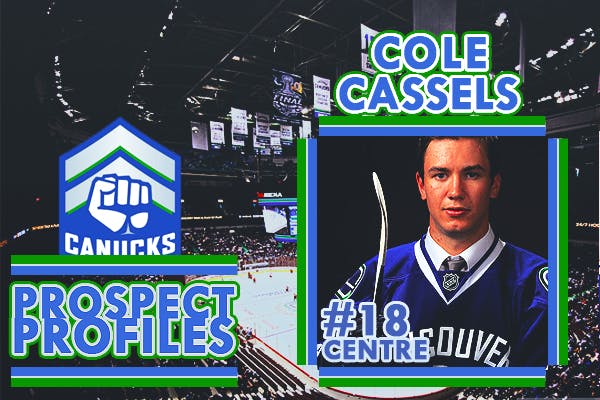Prospect Profile: #18 Cole Cassels
At the 2013 NHL Draft, not long after stunning the hockey world with the consummation of the Cory Schneider deal, the Canucks made Oshawa Generals centreman Cole Cassels their third pick of the draft. A two-way centreman with "NHL bloodlines" (Cassels’ father is former Canucks centreman Andrew Cassels) scouting reports are divided on Cassels’ offensive upside, but uniformly commend his physical play and willingness to block shots. That mostly meshes with what I’ve seen of Cassels in the past.
Cassels played a somewhat limited role and was sheltered behind two excellent two-way OHL centremen in Boone Jenner and Scott Laughton in Oshawa last season. I’d mention that in past viewings, Cassels hasn’t particularly stood out to me as a likely NHL player. Still, I had Cassels a bit higher on my list than 18 (I had him at 15). Based on his age, versatility and production; Cassels represents a better bet to develop into an NHL caliber asset, in my view, than a whole slew of centre prospects who will appear ahead of Cassels on our consensus list.
Read past the jump for more.
Selected with the 85th overall pick at the 2013 NHL entry draft, the Cassels selection bucked several observable trends in Vancouver’s draft strategy. Not only is Cassels somewhat slight of frame – especially in comparison with mid-round picks of the recent past like Alexandre Grenier, Joseph LaBate and Alexadre Mallet – but he’s young for his draft class where the Canucks have tended to prefer overagers outside the first round. Indeed, Cassels only turned 18 seven weeks before the entry draft.
As a sixteen year old rookie in the Ontario Hockey League, Cassels played a fourth-line role and made a name for himself as an agitator and penalty-killer. This past season, as a seventeen year old draft eligible centreman, Cassels stepped up for the loaded Oshawa Generals. Cassels slipped into a top-nine role, fought occassionally and played in all situations – logging major minutes on the penalty-kill and power-play. As his icetime increased, so did his production.
From what I saw this past season, I’d have described Cassels as Oshawa’s third-line centre. But looking at the fossil record (or Cassels’ on-ice goal events on OHL’s prehistoric event summary sheets) suggests something a little bit more complicated. Cassels obviously played up the lineup on occassion in Scott Laughton’s absence last season, and skated occassionally on a line with Lucas Lessio. Still Cassels was seventh among General forwards according to our goal events based time-on-ice estimates, meaning he was firmly a third-liner.
On special teams Cassels was a fixture on Oshawa’s penalty-killing unit and recorded 16 power-play points (six goals, ten assists). He even saw some time on Oshawa’s first-unit towards the latter parts of last season. That power-play production accounted for nearly 38% of Cassels’ point totals, a relatively high rate, should probably be noted but I wouldn’t describe it as worrying.
The real question, I suppose, is whether or not Cassels can continue to be both productive and assertive physically when he’s battling more difficult competition next season. According to our goal events based quality of competition estimates, Cassels faced the weakest competition among all Oshawa forwards a season ago.
Generals centreman Boone Jenner will surely turn pro this fall, and Scott Laughton could conceivably make the Philadelphia Flyers out of training camp. In other words Cassels could well find himself thrust into a key role for the Generals next season, and how he handles it will tell us a lot about how he projects going forward.
For now Cassels is a bit of an unknown quantity. His scoring and icetime exploded between his rookie and sophmore seasons, but he’s yet to really play a top-six role at the major junior level. A former 1st round pick of the Generals and the son of a long-time NHLer, Cassels comes with pedigree, but scouts are generally split on his talent level and projection.
Common refrains include the notion that Cassels "makes it look easy" (which, of course is both praised and criticized) and that he’s a bit too pass-first and might work on his shot selection. The praise for Cassels’ hitting and defensive game is unanimous, but whether or not that will translate at the NHL level is anyone’s guess.
Like all mid-round picks, Cassels is essentially a lottery ticket. There are some red flags that left me underwhelmed by the pick on draft day, in particular his sheltered usage, but those concerns are mitigated somewhat by Cassels’ upside, versatility and relative youth.
Cassels won’t turn 19 until May so he’s got a bit of additional development time remaining over some of his draft cohort (and lots of additional development time remaining over the likes of Kellan Lain and Alexandre Mallet). Which is why Cassels is the right sort of player for the Canucks to gamble on in the middle rounds of the draft, even if he’s something of a long shot – like all third rounders are, mind you – to develop into an impact player at the NHL level.
Other Prospect Profiles in This Series:
Recent articles from Thomas Drance






